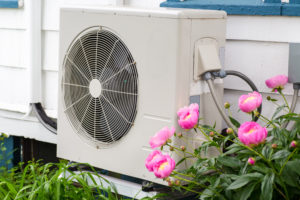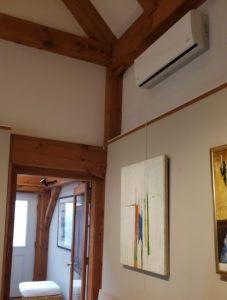By James Booth
Heating buildings by burning fossil fuels such as oil and natural gas accounts for almost half of Belmont’s climate-warming CO2 emissions. A key strategy in Belmont’s Climate Action Roadmap is switching to carbon-free electricity as a pathway to zero emissions. So how can one efficiently heat a building using electricity? The answer is heat pumps.
Heat pumps work by moving heat from one place to another, much like a refrigerator or air conditioner that can also operate in reverse, able to heat in winter and cool in summer. Traditional electrical baseboard heaters or other “resistance” systems convert electrical energy directly into heat, acting much like the hot filament in a toaster. In contrast, heat pumps don’t create new heat. Instead, electricity pumps a refrigerant through a cycle that transfers heat from outside into the house in winter, or vice versa, from inside to out, to cool the house in summer. (Yes, it’s cold outside in winter; that’s why it takes electricity to extract the heat.) Since simply moving heat uses less energy than creating heat, heat pumps use as little as one-third of the amount of electricity to deliver the same amount of heating.

Belmont was selected as one of six communities for the 2019 HeatSmart Mass program, a six-month campaign to move each town toward a more electrified future. One of the solutions being promoted is air-source heat pumps, like the outside unit shown here and the indoor unit on the opposite page. (Cadmus Group photo)
The two types of heat pumps are ground-source, sometimes called geothermal systems, and air-source. The first type, using the ground as the source, or “sink,” for heat, is planned for the new Belmont Middle and High School, and requires more land and construction investment. Alternately, air-source heat pumps (ASHP), which move heat into or out of the outside air, are more practical for most residences.
HeatSmart Belmont is a new community-driven outreach and education campaign to promote the adoption of ASHPs. It is a collaboration between a group of local volunteers, the Belmont Energy Committee, and Belmont Light, with support from Massachusetts Clean Energy Center, a quasi-public state economic development agency, and the Massachusetts Department of Energy Resources, who selected Belmont as one of six communities in their 2019 HeatSmart Mass program. The six-month education campaign is intended to move the town toward an electrified future; it launched in April 2019 and runs through October.
The efficiency of ASHPs results in less CO2 emissions than burning oil or natural gas in your house. As Belmont Light is expected to move its supply toward carbon-free sources, heat pumps effectively get cleaner and cleaner; indeed, even fully emissions-free if electricity became 100 percent carbon-free. Residents can already opt to purchase 100 percent carbon-free electricity today by enrolling in Belmont Light’s Green Choice Program.
Aside from the climate benefit, ASHPs offer homeowners comfort and flexibility, as well as a reduction of combustion sources in your house. Ductless versions, or mini-splits, allow setting up heating zones in the home, without installation of expensive ductwork. ASHPs also operate more quietly than some “window-rattler” air conditioners.

Indoor wall-mount heat pump unit (Cadmus Group photo)
A common misconception is that heat pumps don’t work well in the cold climate of the Northeast. However, the technology has improved in the last decade. Today’s cold-climate air-source heat pumps work at full capacity down to 5°F and function to below minus 13°F. Over 40,000 cold-climate heat pumps have been installed in Vermont and Maine since 2013—states with colder winters than our own.
Much of Belmont’s housing stock is old and in need of weatherization. Changing one’s heating and cooling systems is a time to think about improving the building envelope, since a well-insulated house can be heated with a smaller heating system. The HeatSmart Belmont website lists a variety of incentives for heat pumps as well as improvements like insulation and air sealing.
Heat pumps offer operating cost savings over electric-resistance or oil systems. Of course, generating electricity from rooftop solar also offers substantial savings. However, natural gas, at its currently relatively low price, is comparable to heat pumps, so cost is not a driver to switch from natural gas until prices rise again.
HeatSmart Belmont has selected Muirfield Mechanical Services as its installer. They are currently scheduling visits with Belmont residents to assess if heat pumps can address their heating and cooling needs, and also help them access current Belmont Light and state incentives.
James Booth is a member of the Belmont Energy Committee, a co-author of its Climate Action Roadmap, and a HeatSmart Belmont coach.
Learn more about Belmont businesses and residents who are using geothermal heat pump heating and cooling in the next issue of the Belmont Citizens Forum Newsletter.


Sorry, the comment form is closed at this time.